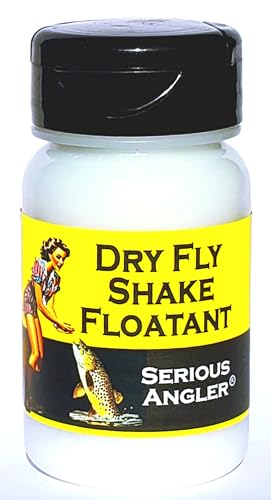Trout feed below the surface 80% of the time and that statistic should push the rational trout angler to fish exclusively with nymphs to catch more fish. However, the excitement of a trout slurping a dry fly on the surface is compelling and is the visual pot of gold at a rainbow ending in a sparkling pool high in the mountains. But trout are picky about what they eat and not easily fooled by improperly presented dry flies. To be effective, the fly should ride high and dry above the surface film – even in turbulent water.
Floatants to the rescue! A good floatant will keep the fly from absorbing water and sinking. As a new fly angler, you probably have three questions:
- What are the options?
- When to use?
- How to use?
What: Floatant types include paste, gel, liquid, and powder. Pastes (an example is Loon Outdoors Payette) are thick and hard to apply in cold weather. Gink and Aquel are the most common gel floatants. The disadvantage of the gel is it liquefies in hot weather and, once liquid, is easy to waste or overapply as the fluid squirts out of the bottle. Fly-agra and HydroStop are the best-known liquid floatants and should be applied 24 hours in advance. Powders (Frog’s Fanny aka hydrophobic fumed silica) coat the fly to repel water and mimic small air bubbles.
When: Only apply floatant to a dry fly. Adding floatant to a wet fly merely seals the water in the fibers. Some powdered floatants, like Shimazaki Dry Shake, are the exception since they can both absorb water from the wet fibers and coat the fly to repel future water based on their mix of ingredients. Avoid false casting to dry a fly since that is a lot of unnecessary work, and a flailing line may spook the fish. Instead, cut a chunk of automotive chamois or use an amadou patch to wrap around the fly and pinch dry. Both of these materials pull water from the fly; leaving it ready for another dose of floatant.
How: Paste should be your last choice of floatant. Its utility is limited to large flies with its real purpose being to add buoyancy to a yarn indicator or refloating a dirty fly line. Never put paste or gel directly on the fly since you will end up using too much. Squeeze a small amount on your fingertip, turn the fly upside down and treat the bottom part of the fly body and fibers since those are the parts in contact with the water. The wings do not need treatment. After catching a fish, rinse the slime off the fly and remove water with the chamois or amadou patch before treating.
Never use generic gel on a CDC fly. Fly tyers create these using the wispy feathers associated with the oil glands of ducks, geese, and turkeys. The oil coating is a natural waterproofing treatment that allows these flies to float just fine. If a CDC fly needs help floating, use powder. For gel enthusiasts, Loon Lochsa and Tiemco Dry Magic gels are the only ones I know of that are compatible with CDC flies. Since the material is unique and drives a higher price point, CDC flies have “CDC” somewhere in the name (CDC Caddis, CDC Trico, etc.). As a rule, only put gel on flies larger than size 16 (smaller number – a size 14 is bigger than size 16) since it ends up overpowering smaller flies.
You can use powdered floatant on all sizes, but it excels on smaller flies. Drop the fly in the powder container and shake or use the included brush to apply. Be careful with powders since the fumed silica is a carcinogen; so hold your breath while using!
Liquid floatant permanently waterproofs the fly but is not intended for streamside use. Dip it into the liquid and allow it to dry for at least a day. Even if you pretreat the fly with liquid, you may still want to use a powder since it mimics small air bubbles; adding to the realism of the presentation.
For those who look for the do-it-yourself alternative, you have two easy choices. Albolene Moisturizing Cleanser, available at drugstores and Walmart (12 oz for $10), mimics the function of gel and softens your skin at the same time! Buy a bottle of Frog’s Fanny and save the bottle. Then, order two quarts of hydrophobic fumed silica for around $25 from Amazon for a lifetime replacement supply (search for ‘fumed silica powder fly floatant’). It is challenging to get the powder into the Frog’s Fanny bottle, so I recommend you watch the video on my YouTube channel that shows the easy way using a turkey baster.
For those who would like to read a fantastic comparative head-to-head test of the leading brands of floatant, visit Troutster.com or search for “The Fly Floatant Test.”




